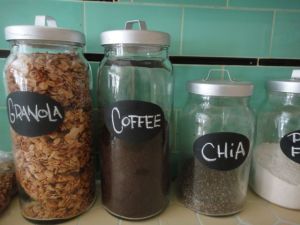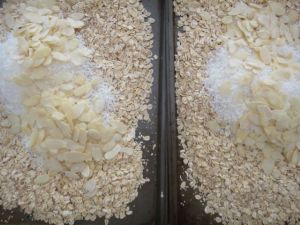Recipe: Homemade Granola
Post by Olivia Martino, Registered Dietitian and Co-Owner, Nourish Northwest
Whether or not you celebrate Easter, you may be looking for a delicious, healthy recipe to add to your breakfast repertoire. This one is a staple in my house and whenever that jar gets low I make sure to whip up another batch. It works great for breakfast, a snack or even to satisfy a sweet tooth. Enjoy!
Homemade Granola
Total time: 45 minutes
Yields: 6 cups; Serving size: ½ cup
Ingredients:
- 2 cups rolled oats
- ½ cup sliced almonds, walnuts, pecans or hazelnuts
- 1 cup unsweetened coconut
- 1 tsp salt
- ¼ cup olive oil or melted coconut oil
- 1/4 cup maple syrup
- ¼ cup honey
- ½ cup dried, unsweetened fruit (optional)
Directions:
- Preheat the oven to 275 degrees F.
- Spread the oats, nuts and coconut on a baking sheet with sides. Sprinkle with salt and bake for 12-15 minutes, stirring occasionally, until the ingredients are lightly toasted but not yet golden. Transfer the ingredients to a large bowl.
Quick Weeknight Meal: Noodle Bowl
Post by Paula Jahn, Co-owner and Dietitian at Nourish Northwest
Pasta has always been my quick default weeknight meal. It serves as an excellent base for fridge clean-out meals, too. I usually start with 100% whole wheat fusilli or penne pasta and add the remains of the vegetable crisper to make a simple sauce. Sometimes I add meat, sometimes not. For a gluten free version, I used to keep the same types of pasta in brown rice form. With recent reports of possible contamination of arsenic in rice and rice products, I decided to reduce my and my family’s exposure by diversifying my noodles. I’ve tried three main types of rice- and gluten-free noodles: quinoa/corn based, 100% buckwheat soba noodles, and mung bean. Buckwheat soba comes out ahead in terms of both taste and nutrition. They are nutty, hold their shape and chewiness after cooking, and are higher in iron, calcium and zinc compared to regular whole wheat noodles.



Soba noodle salads are versatile but can be somewhat involved with many ingredients. They are popular served cold with a soy sauce based dressing and lots of crunchy vegetables. The cold salad noodles are great for lunch, but fore dinner, I usually want something warm. It just feels more satisfying than a cold noodle salad.
The following recipe is quick, simple, nutritionally balanced and not boring. I love the “pesto” with the coconut milk. I only added two vegetables to keep it really fast, and only one required chopping. Yeah for frozen peas!

Coconut Soba Noodles
(recipe adapted from Bev Cooks)
Serves 3-4
2 cloves garlic, roughly chopped
1-inch piece of fresh ginger, roughly chopped
1 stalk lemongrass, rough outer leaf pulled away, and the remaining stalk finely sliced
1 jalapeño pepper, chopped (seeds and ribbing removed for less heat)
1/2 cup cilantro or flat parsley leaves, plus extra for garnish
2 Tbs. lime juice
1 pinch coarse salt
1 Tbs. coconut oil
1 (15 oz) can coconut milk (you can use light if you prefer)
3 bundles soba noodles
1 red bell pepper, stemmed, seeded and cut into small strips
1 cup frozen peas
black sesame seeds for garnish (optional)
In a small food processor, combine the garlic through the pinch of salt. Blitz until the mixture is finely minced.
Heat the coconut oil in a medium pot over medium-high. Add the pesto mixture and bloom in the oil for a minute.
Whisk in a little of the coconut milk. Then pour the rest in and whisk until fully combined.
In the meantime, cook the soba noodles in boiling water until they reach al dente, about 6 minutes.
Drain the water and transfer the noodles to the coconut milk. Add the red bell pepper and peas. Toss to heat everything through, a minute or so.
Serve garnished with cilantro and black sesame seeds.
Cashew Cream: A Vegan’s best friend
Post by Olivia Martino, Registered Dietitian and Co-Owner, Nourish Northwest
Before we started teaching Vegan Cooking Classes, I knew I had a good handle on how to make a delicious veggie-centric meal while avoiding all animal products. But I wanted to become an expert on making these dishes really stand out, be satiating and balanced. I wanted to master some of the “tricks” to make vegan meals something that anyone could find delicious, even meat eaters. The key was replicating some of the flavors and properties of animal foods. Paula wrote an important piece about this last week, discuss how to create that savory, umami flavor in veggies. This week I am discussing how to replicate the creaminess that dairy typically provides.
The answer is simple and unsuspecting. The cashew.

Cashews are a sweet, soft nut high in protein, iron, magnesium, zinc and healthy fat. When blended together with water they make a beautiful cream, lending itself to many uses. Playing with the amount of water and time blending, can alter the consistency of the cream. If you want a really thick cream to add some body to a soup, you will add very little water. Or if you want to make a “cheese” out of the cashews, you would add even less. If you are looking for a runnier texture to use as a garnish or dressing, add a good amount of water. For best results, soak the cashews overnight or at least a few hours before blending.


The cashew cream is a blank slate. You can add whatever herbs and seasonings you like to give it some flavor. Here are some of our favorite uses:
Cashew Cream as a garnish to soup

CASHEW CREAM
(Adapted from The Cancer-Fighting Cookbook by Rebecca Katz)
INGREDIENTS
2 cup raw cashews
2 cup water
2 tsp freshly squeezed lemon juice or orange juice
1⁄2 tsp sea salt
1⁄8 tsp freshly ground nutmeg
PROCEDURE
- Grind the cashews in a processor for a couple pulses to give them a head start
- Add the water, lemon juice, salt, nutmeg and blend until creamy smooth. This takes several minutes for the mixture to resemble heavy cream.
Cashew cream to thicken soup

CASHEW CREAM THICKENER
INGREDIENTS
1 cup cashews
water
PROCEDURE
Cover cashews in water and soak overnight. Drain and place in food processor. Blend with a couple of tablespoons of water, adding more if cream is too thick to move.
Cashew Based Salad Dressing

CASHEW RANCH DRESSING
- 1 cup raw cashews
- 1 teaspoon garlic powder
- 1 tablespoon lemon juice
- ½ teaspoon sea salt
- ¼ cup water
- ¼ cup parsley, chopped
- 1 small bunch chives, chopped (about 2 tablespoons)
- freshly-ground black pepper to taste
- Add cashews to a small bowl and soak in water for at least 15 minutes. (This will allow the cashews to soften and make them easier to process.)
- Drain cashews of the water and add to a blender or food processor, along with garlic powder, lemon juice, salt, and ¼ cup of water. Blend or process, until smooth, adding additional water as needed, until the mixture is the consistency of dressing.
- Add the parsley and chives, along with pepper to taste, and refrigerate until using.
Sweet Cashew Cream

We love to make a fruit dip by blending cashews, a small amount of water, maple syrup, vanilla and cinnamon… it’s so amazing, it’s hard not to eat it by the spoonful. If you want to take it to the next level, try this delicious cheesecake recipe.
CHEESECAKE FILLING
- 65g cashew nuts, soaked overnight in water and drained
- Juice of 2 lemons
- 1/4 cup maple syrup
- 1/4 cup coconut oil, melted
- 1 tsp vanilla extract
- 3 pitted dates
- 6 large strawberries
- Make your favorite nut based crust and press into fill muffin liners (We typically just blend together some almonds, dates and coconut oil)
- Blend together the cashew nuts, maple syrup, coconut oil and vanilla until it makes a smooth silky mixture. Pour the mixture onto each of the cheesecake bases until it fills the top.
- Make the strawberry swirl by blending together the dates and strawberries then dropping a few dots of the mixture onto the top of the cheesecakes. Use a skewer to gently swirl the strawberry mixture around.
- Place the cheesecakes in the freezer overnight or for at least 4 hours to set.
- Sit at room temperature before serving and enjoy!
Umami in Vegetables
Post by Paula Jahn, Co-owner and Dietitian at Nourish Northwest
Umami, dubbed the fifth taste, is described as a savory or meaty flavor. Its sensation is attributed to free amino acids, primarily glutamate (also inosinate and guanylate) in foods. Unlike sweet, sour, salty, and bitter, umami is more difficult to identify on the tongue. Its essence is a round, robust flavor. Think about the difference in flavor between a pale, out-of-season tomato and a ripe one picked in the heat of the summer. Researchers measured the level of glutamate in unripe versus ripe tomatoes and found unripe ones to contain less than 50 mg/100 g while ripe tomatoes contain more than 200 mg/100g of glutamate. Umami is certainly more elusive than the other four tastes (few mistake the sourness of lemon or the sweetness of honey), but just as important to taking a dish to its full potential. When a dish is just “missing something,” that something is usually umami.

Umami’s complexity is traditionally exemplified and celebrated in animal foods. Parmesan cheese, aged meats, anchovies, and seared meat/seafood are all famously rich in the satisfying umami taste. Vegans, do not despair! There are plenty of vegetarian sources of umami, it’s just a matter of knowing where they are and how to harness them in cooking. Read on for plant-based sources of the intangible fifth taste.
Sun Dried Tomatoes or Tomato Paste

As mentioned above, tomatoes contain a natural source of free glutamates. This becomes amplified and concentrated when the tomatoes are sun dried or turned into paste. Add sun dried tomatoes to pasta, polenta, or roasted vegetables. Caramelized tomato paste adds an interesting umami flavor to lentil soup.
Mushrooms

Mushrooms are one of the best sources of naturally-occurring umami in the pant world. Sear them in a skillet with a little oil or make a broth out of dried mushrooms to get the most flavor.
Fermented Things (also boast healthful probiotics)

Fermentation brings out the free amino acids that excite the umami buds on the tongue. There are many plant sources of this:
Miso, sauerkraut, tempeh, kimchi, tamari, soy sauce, plum vinegar…These are all excellent pantry staples. When you’ve added yet another pinch of salt and the dish just needs something, try one of these fermented wonders.

Sea Vegetables
Edible seaweeds are the winner in the world of vegetable-based umami sources. Nori and kombu are especially high in umami. Nori are the toasted sheets of seaweed that wrap our favorite sushi rolls. Kombu is a traditional component to dashi (vegans, omit the bonito flakes), the broth used as a base for miso soup. Hey, you’ve got a two-for-one umami blast there!

There are many ways to round out a vegetarian meal with umami rich foods. This is something I preach in every cooking class: watery steamed vegetables are not a vegan’s fate. Be bold and put some umami into every meal!
Healthy Recipe Resource Guide
Post by Olivia Martino, Registered Dietitian and Co-Owner, Nourish Northwest
We have been getting asked a lot lately for healthy recipe blogs and websites. Here are some links to our favorites that we use frequently!
Oh She Glows: This is the blog (and cookbook) we use most frequently for vegan recipe. Many of her recipes are also gluten free. She has a lot of great recipes up there, from smoothies to entrees, soups, salads and desserts. We have found some of the most delicious dessert recipes on this blog (hint: chocolate torte!), but we have also had a few dessert fails, so we recommend testing these recipes out before preparing them for a group.
Post Punk Kitchen: This is another great source for vegan recipes, that we use often but we do find the recipes can be somewhat involved.
101cookbooks: Great resource for very simple, healthy vegetarian recipes.
Sprouted Kitchen: Lots of great, veggie based meals and beautiful photographs.
EatingWell: Hundreds of healthy recipes from vegan to meat based. We love the organization of this website, which easily allows you to search for recipes by ingredient, course, budget, health consideration and holiday.
TheKitchn: This website posts several short entries daily, ranging from recipes to kitchen tips to ingredient spotlights.
And here are some more links that we have used, as well:
Cookie and Kate: Vegetarian Recipes
Nourished Kitchen: Traditional Foods
Gluten Free Girl: Recipes and resources, especially helpful for the newly diagnosed gluten sensitivity
Dishing up the Dirt: Local Hood River farmer, who has posted several healthy, plant based recipes
My New Roots: Whole food, plant based recipes
Naturally Ella: Seasonal, vegetarian recipes






